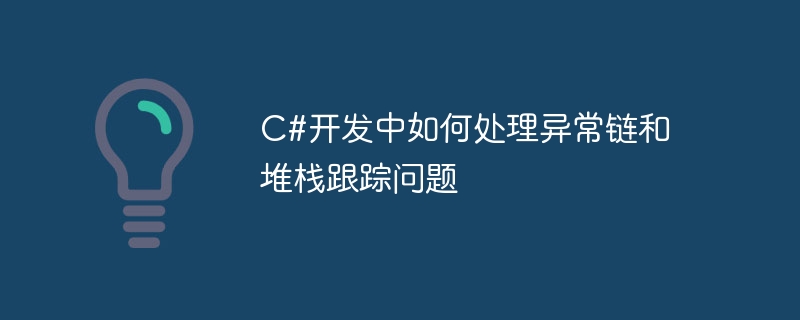

How to handle exception chains and stack traces in C# development requires specific code examples
Introduction:
In C# development, handling exceptions is crucial a part of. When an error occurs when our program is running, correct handling of exceptions can not only improve the reliability of the program, but also help us better track and repair errors. This article will introduce how to deal with exception chain and stack trace issues, and how to use the exception classes and related methods provided by C# to implement exception handling.
1. What are exception chains and stack traces?
In C# development, when a method throws an exception, a new exception object is created and passed to the upper method that calls the method. This transfer of exceptions can form an exception chain. The exception chain can provide more error information to facilitate error location and repair.
Stack Trace refers to recording the execution path of the code when an exception occurs. Stack trace information can tell us the specific location where the exception occurred, helping us locate and solve the problem.
2. Exception chain processing skills
The following is a sample code:
try { // ... throw new Exception("异常1"); } catch (Exception ex1) { try { // ... throw new Exception("异常2", ex1); } catch (Exception ex2) { Console.WriteLine($"异常链: {ex2}"); } }
In the above example, an Exception object with an InnerException parameter is thrown in the first catch block. In the second catch block, we can get the ex1 exception object through the InnerException property of the ex2 object. By printing the ex2 exception object, we can see the complete exception chain information.
try { // ... } catch (Exception ex) { Console.WriteLine("异常链:"); Exception innerException = ex; while (innerException != null) { Console.WriteLine(innerException.Message); innerException = innerException.InnerException; } }
In the above example, we used a while loop to traverse the exception chain. By printing the Message property of the internal exception, we can output the error information of each exception in the exception chain in sequence.
3. Stack trace information processing skills
The following is a code example:
try { // ... } catch (Exception ex) { Console.WriteLine("堆栈跟踪信息:"); Console.WriteLine(ex.StackTrace); }
In the above example, we output the stack trace information by printing the StackTrace property of the ex exception object.
try { // ... } catch (Exception ex) { Console.WriteLine("堆栈跟踪信息解析:"); string stackTrace = ex.StackTrace; string[] stackFrames = stackTrace.Split(' '); foreach (string stackFrame in stackFrames) { if (!string.IsNullOrEmpty(stackFrame.Trim())) { Console.WriteLine(stackFrame.Trim()); } } }
In the above example, we split the stack trace information into multiple lines based on newlines and then output them line by line. In this way, we can see the specific function calls and location information.
Conclusion:
In C# development, exception chains and stack traces are important components of exception handling and error tracking. By making reasonable use of exception classes and related methods, we can obtain information about exception chains and quickly locate and fix problems based on stack trace information. Properly handling exception chains and stack trace issues can not only improve the reliability of the program, but also improve our development and debugging efficiency.
The above is the detailed content of How to deal with exception chain and stack trace issues in C# development. For more information, please follow other related articles on the PHP Chinese website!
 The difference between console cable and network cable
The difference between console cable and network cable How to calculate the refund handling fee for Railway 12306
How to calculate the refund handling fee for Railway 12306 mcafee upgrade package
mcafee upgrade package What is agp interface
What is agp interface How to deal with laptop lag and slow response
How to deal with laptop lag and slow response What should I do if my computer won't turn on?
What should I do if my computer won't turn on? How to delete ktpcntr.exe
How to delete ktpcntr.exe How to configure jdk environment variables
How to configure jdk environment variables



